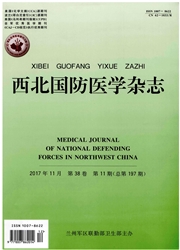

 中文摘要:
中文摘要:
目的:探讨川芎嗪联合缬沙坦治疗糖尿病肾病肾衰竭的临床疗效。方法:选择我院2011年1月至2013年1月收治的糖尿病肾病肾衰竭患者96例,并将其随机分为实验组和对照组,每组48例。两组患者均根据病情给予对症支持治疗,并严格控制血糖。在常规治疗基础上,实验组患者给予川芎嗪注射液240 mg,静脉滴注,1次/d,同时给予缬沙坦80 mg,口服,1次/d,21天为1个疗程;对照组患者给予缬沙坦80 mg,口服,1次/d,21天为1个疗程。1个疗程后观察两组患者的临床疗效、血液学指标、尿检指标等实验室检查。结果:治疗21天后,实验组的临床有效率达83.3%,显著高于对照组(60.4%),差异具有统计学意义(P〈0.05);两组空腹血糖、尿蛋白、尿素氮、血肌酐水平均较治疗前显著改善,且实验组以上指标及胆固醇水平的改善程度明显优于对照组,差异有统计学意义(P〈0.05)。治疗过程中,两组均无严重不良反应发生。结论:川芎嗪联合缬沙坦可以更有效地改善糖尿病肾病肾衰竭患者的临床疗效,有一定的临床应用价值。
 英文摘要:
英文摘要:
Objective: To investigate the clinical efficacy of Valsartan plus Tetramethylpyrazine injection in the treatment of dia- betic nephropathy renal failure (DNRF). Methods: 96 cases of DNRF patients admitted in our hospital from January 2011 to January 2013 were selected and randomly divided into the Valsartan group (control group) and Tetramethylpyrazine injection plus Valsartan group (experimental group). Based on the conventional treatment and control of blood glucose, the control group was treated with 80 mg Valsartan by oral once a day for 21 days. At the same time, the experimental group was treated with Tetramethylpyrazine injection 240 mg by intravenous infusion once a day and Valsartan for 21 days. The therapeutic effect, hematology and urinary index were observed and compared between two groups. Results: After 21 days' treatment, the clinical efficacy of experimental group was 83.3%, which was significantly higher than that of the control group (60.4%, P〈0.05). The fasting blood glucose, urine protein, blood urea nitrogen, serum creatinine levels were significantly improved after treatment of both group, and the above index as well as cholesterol levels of the experimental group were more significantly improved than those of the control group (P〈0.05). In the course of treatment, no serious adverse effects was in two groups. Conclusions: Tetramethylpyrazine injection plus Valsartan could significantly improve the therapeutic effect of DNRF patients.
 同期刊论文项目
同期刊论文项目
 同项目期刊论文
同项目期刊论文
 Changes in Hepatic Blood Flow During Transcatheter Arterial Infusion with Heated Saline in Hepatic V
Changes in Hepatic Blood Flow During Transcatheter Arterial Infusion with Heated Saline in Hepatic V Effect of transarterial pulsed perfusion with heated saline on tumor vascular permeability in a rabb
Effect of transarterial pulsed perfusion with heated saline on tumor vascular permeability in a rabb Role of prophylactic filter placement in the endovascular treatment of symptomatic thrombosis in the
Role of prophylactic filter placement in the endovascular treatment of symptomatic thrombosis in the The effect of adenovirus-conjugated NDRG2 on p53-mediated apoptosis of hepatocarcinoma cells through
The effect of adenovirus-conjugated NDRG2 on p53-mediated apoptosis of hepatocarcinoma cells through 期刊信息
期刊信息
